
Capitol Records MONO Original Released
10 "Yesterday"... And Today (A.K.A. Butcher Cover) (T-2553)
(Update: 13th. November 2023)



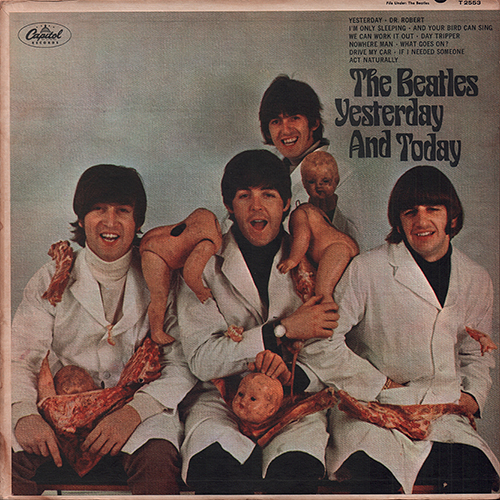 Capitol 3rd. State Sleeve |
|
|
|
TITLE
|
"Yesterday"... And Today |
||||||||||||||||||||||||||||
| CATALOG
NUMBER |
T-2553 |
||||||||||||||||||||||||||||
|
RELEASE DATE
|
20th. June 1966 / Second State (First
Press: 15th June. 1966) |
||||||||||||||||||||||||||||
| TITLE LISTING |
SIDE
1 |
SIDE
2 |
|||||||||||||||||||||||||||
| Drive My Car
(BMI-2:25) |
And Your Bird Can
Sing (BMI-2:02) |
||||||||||||||||||||||||||||
| I'm Only Sleeping (BMI-2:58) | If I Needed
Someone (BMI-2:19) |
||||||||||||||||||||||||||||
| Nowhere Man (BMI-2:40) | We Can Work It
Out (BMI-2:10) |
||||||||||||||||||||||||||||
| Dr. Robert (BMI-2:14) | What Goes On? (BMI-2:44) | ||||||||||||||||||||||||||||
| Yesterday (BMI-2:04) | Day Tripper
(BMI-2:47) |
||||||||||||||||||||||||||||
| Act Naturally
(BMI-2:27) |
|||||||||||||||||||||||||||||
| FRONT--> Click! | BACK --> Click! | SIDE 1 --> Click! | SIDE 2 --> Click! | DISK | |||||||||||||||||||||||||
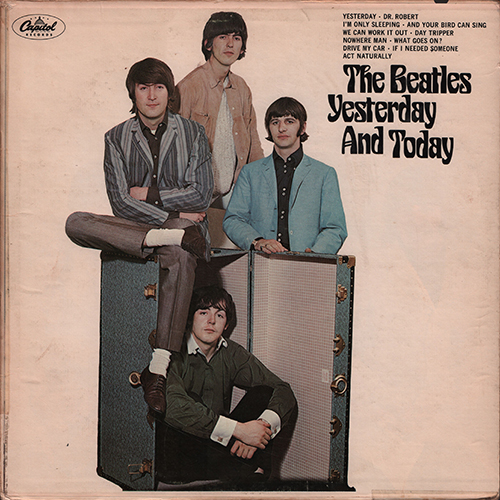 |
 |
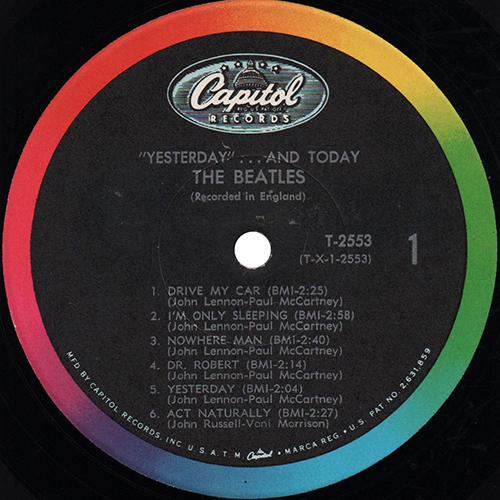 |
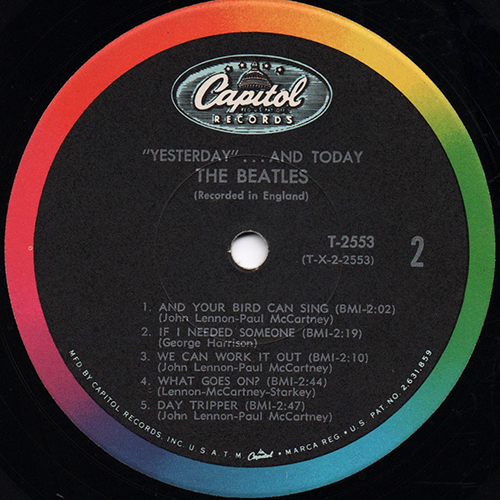 |
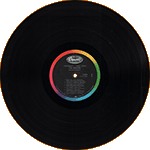 |
|||||||||||||||||||||||||
| INNER SLEEVE | FRONT COVER CLOSE UP | ||||||||||||||||||||||||||||
| FRONT --> Click |
BACK --> Click! |
||||||||||||||||||||||||||||
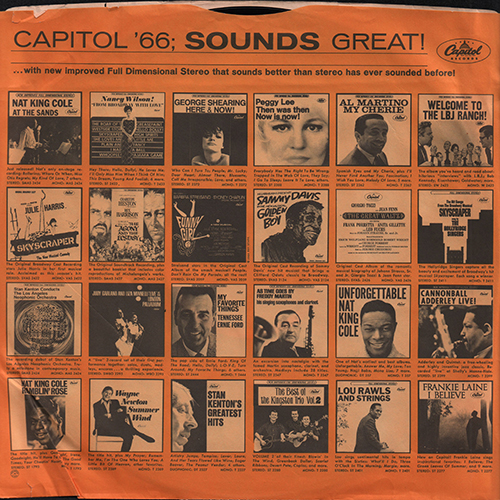 |
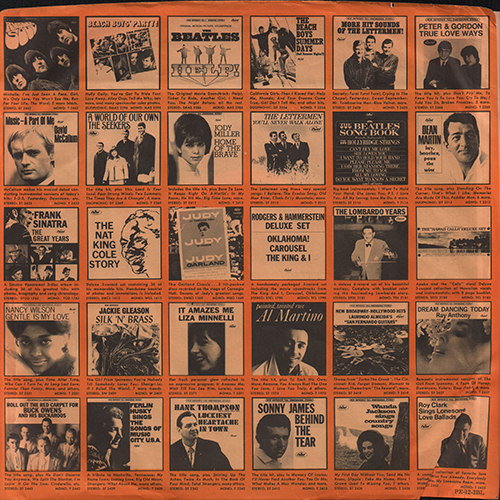 |
 |
|||||||||||||||||||||||||||
 |
Capitol Company Sleeve Type-6-2:
Orange sleeve (Sound Great!) Curved cut top. "Printed in U.S.A." mark was printed at the bottom of the back. |
||||||||||||||||||||||||||||
| FRONT COVER CLOSE UP --> Click | |||||||||||||||||||||||||||||
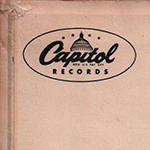 |
The Capitol logo (without the phrase "HIGH FIDELITY") appear in black in the upper left corner of the front sleeve. | 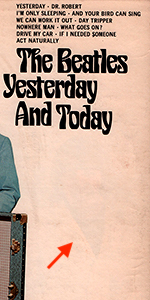 |
The newly pasted
over photo is known as the "TRUNK COVER". To make certain that the album is an actual 2nd STATE BUTCHER COVER, one easy way to tell is to look at the right side on the front cover about midway down. You will see a faint depiction of Ringo's Black V-Neck Shirt underneath. |
||||||||||||||||||||||||||
 |
|||||||||||||||||||||||||||||
| The exposed
portion of the back liner that wrapped around to the top of
the jacket has the phrase "File Under: The Beatles" as well
as a large black dot and the catalogue number. However, it is hidden behind the "trunk cover" sheet. |
|||||||||||||||||||||||||||||
| BACK COVER CLOSE UP | |||||||||||||||||||||||||||||
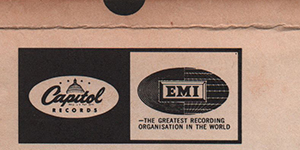 |
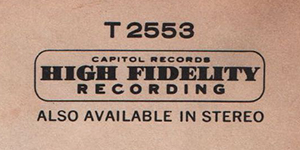 |
Capitol/EMI logo was printed at the upper
left of the back cover. The High Fidelity Recording logo and "Also available in stereo" in uppercase letters in the upper right corner. |
|||||||||||||||||||||||||||
 |
Bill Miller: An
American producer and from 1952, director of Capitol
Records' international A&R operation. |
||||||||||||||||||||||||||||
| BACK COVER CLOSE UP | |||||||||||||||||||||||||||||
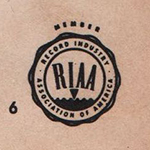 |
 |
||||||||||||||||||||||||||||
| The
lower portion of the back liner contains "MADE IN U.S.A. •
FACTORIES: SCRANTON, PA. - LOS ANGELES, CALIF. -
JACKSONVILL, ILL." and the RIAA (Record Industry Association
of America" logo. Most of the back liners have a small
numeral located near the lower right or left corner. These
numbers were used by Capitol to identify where the album
cover was manufactured. (6=L.A. factory) |
|||||||||||||||||||||||||||||
| LABEL CLOSE UP | |||||||||||||||||||||||||||||
 |
The original issue Capitol albums were manufactured with black label backdrops with an outer rim colorband. | 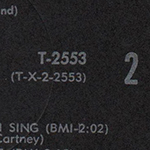 |
Catalogue number "T-2553" was printed at
the right side of the center hole. "West Coast" Pressings have the master number aligned right. |
||||||||||||||||||||||||||
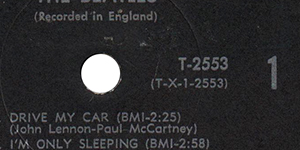 |
Catalogue number "T-2553" was
printed at the right side of the center hole. The labels for records manufactured on the East Coast were printed by Keystone Printed Specialties, Inc. in Scranton, Pennsylvania. The labels for the West Coast were printed by Bert-Co Enterprises in Los Angeles, California. The labels can be differentiated by the font of the number "one" at nine o’clock on the side one labels. |
||||||||||||||||||||||||||||
| LABEL CLOSE UP | |||||||||||||||||||||||||||||
| SIDE 1 --> Click! |
SIDE 2 --> Click! |
The First Pressings'
credits all songs on both sides as BMI. |
|||||||||||||||||||||||||||
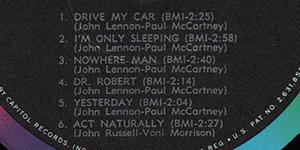 |
 |
||||||||||||||||||||||||||||
| LABEL CLOSE UP | |||||||||||||||||||||||||||||
 |
The text of the perimeter print in blue on the original issue discs states "MFD. BY CAPITOL RECORDS. INC. U.S.A. T.M." to the left of a small Capitol logo, with "• MARCA REG. • U.S. PAT. NO. 2, 631,859" to the right. On some labels, the perimeter print is in white. | ||||||||||||||||||||||||||||
|
OTHER ITEM
|
|||||||||||||||||||||||||||||
| - | |||||||||||||||||||||||||||||
| LABEL | Capitol
Black
label
with color band type-1 |
||||||||||||||||||||||||||||
| MIX | MONO |
||||||||||||||||||||||||||||
| VINYL COLOR | Black |
||||||||||||||||||||||||||||
| PRESS FACTORY |
SLEEVE | West
Coast: Bert-Co Enterprise of Los Angeles |
|||||||||||||||||||||||||||
| VINYL | Los
Angeles, California |
||||||||||||||||||||||||||||
| FACTORY CODE | 6 |
||||||||||||||||||||||||||||
| MATRIX No. | SIDE 1 |
T-1-2553-G-24'
(hand etched) 2 * (machine stamped) |
|||||||||||||||||||||||||||
| SIDE 2 |
T-2-2553-G-18'
(hand
etched)
1 * (machine stamped) |
||||||||||||||||||||||||||||
| PUBLISHER'S NAME |
- |
||||||||||||||||||||||||||||
|
"SUBSIDIARY" PRINT
|
- |
||||||||||||||||||||||||||||
| COVER FORM |
Single
type.
Housed
in a cardboard jacket. “Peeled” versions with the trunk cover removed |
||||||||||||||||||||||||||||
| INNER SLEEVE | Capitol
Company Sleeve Type-6-2 Orange sleeve (Sound Great!) / Tub cut top / with "Printed in U.S.A." mark on back. |
||||||||||||||||||||||||||||
| COVER DESIGN/ PHOTO/ NOTES | Photo:
Robert
Whitaker
(from an March, 1966 photo session) |
||||||||||||||||||||||||||||
| PRODUCER | Produced
by
Geore
Martin |
||||||||||||||||||||||||||||
|
COMMENTS
|
"Yesterday and Today" is the
Beatles' tenth Capitol Records release in the United States.
The LP was released in both mono and stereo versions. This was Capitol Records remedy to marketing an acceptable album cover for their latest album issued on JUNE 20, 1966, entitled THE BEATLES' "YESTERDAY and TODAY". This variation is referred to as a 2nd STATE MONO BUTCHER COVER because the original cover was pasted over with this new and more publicly acceptable cover design as shown here. Since the original was found to be somewhat offensive, over the top and rejected by public opinion, reviewers, disc jockeys and especially the record executives at Capitol Records. TRUNK COVER The newly pasted over photo is known as the "TRUNK COVER". This corrected cover version was released on JUNE 20, 1966. To make certain that the album is an actual 2nd STATE BUTCHER COVER, one easy way to tell is to look at the right side on the front cover about midway down. You will see a faint depiction of Ringo's Black V-Neck Shirt underneath. If you don't see this, it's only a standard LP. Overall it's a magnificent piece, a highly sought after collectible, and of Museum Quality in this condition. It's also a 1st PRESSING from Capitol's LA Pressing Plant. On the back of the cover, you will note the Number "6" in the lower right corner. This signifies that it is an LA Pressing which were the VERY FIRST to be produced. As Beatles albums had continued to sell well since their arrival in America in early 1964, Capitol had high hopes for sales of Yesterday and Today. In anticipation of this, the company printed some 750,000 covers at their three pressing plants 1) Los Angeles, California 2) Scranton, Pennsylvania 3) Jacksonville, Illinois. At the Jacksonville, Illinois, plant, all of the returned copies had the records removed and the covers were reportedly taken to a landfill, where they were dumped into a hole that was then filled with water. At the Los Angeles and Scranton plants, a different decision was reached – the cover slicks with the new artwork would be pasted over the existing “Butcher cover” slicks. This process proved to be less expensive than reprinting the covers completely, but was also more time consuming. Not only was the process of precisely aligning a new slick over the old one a difficult task, but the finished covers also had to be trimmed at the mouth (the right edge) to account for any misalignment at the opening of the cover. Once the covers were either reprinted (Jacksonville) or modified (Los Angeles and Scranton), the albums were again shipped to distributors for their June 20, 1966 release date. It’s worth noting that the Butcher cover was released in the United States only in the vinyl format. Reel to reel tape and 8 track tape versions of the album were not issued until about a month after the record. By this time, the decision to use the second cover had already been made. Cassette copies of Yesterday and Today were not released until two years later and all of them were issued with the later trunk cover photo. On the day of release, the album that most buyers saw in the stores was the second cover with the steamer trunk photo. Probably half of those actually had Butcher cover slicks underneath them. A small handful of original copies with the exposed Butcher cover slick were sold at retail, though it has been estimated that only a few hundred copies were sold this way. There have been a couple of copies offered for sale on the market over the years that still had both the original shrink wrap and price sticker intact, demonstrating that at least a few copies of the withdrawn original cover did reach store shelves. Within a few months, all of the “pasteover” copies of Yesterday and Today had been sold, and by the end of 1966, all of the copies seen in stores were copies that had been manufactured with the trunk cover only. By January, 1967, four distinctly different versions of Yesterday and Today were in existence. 1) 1st. State: the original issues with the “Butcher cover” photo 2) 2nd. State: the second version of the album, with the trunk cover slick pasted over the Butcher cover 3) 3rd. State: the buyer-created “peeled” versions with the trunk cover removed 4) Trunk Cover (4th. state): the fourth version, which was manufactured with the trunk cover slick. (from: RareRecord.net "The Butcher Cover - The Beatles' Best Known Album") The back liner contains "MADE IN U.S.A. • FACTORIES: SCRANTON, PA. - LOS ANGELES, CALIF. - JACKSONVILL, ILL."" and the RIAA (Record Industry Association of America" logo. Most of the back liners have a small numeral located near the lower right or left corner. These numbers were used by Capitol to identify where the album cover was manufactured. Capitol did not fabricate its own album covers. Capitol required the cover manufacturer to place a factory identification number on the back liners. The fabricators added a small number, usually in the lower right corner. The following factories used the following identification numbers in the mid-60s:
The original issue Capitol albums were manufactured with black label backdrops with an outer rim colorband. Label copy information specific to each album appears in silver print. The labels for records manufactured on: 1) The East Coast were printed by Keystone Printed Specialties, Inc. in Scranton, Pensylvania. 2) The West Coast were printed by Bert-Co Enterprises in Los Angeles, California. The East Coast and West Coast mono label variations: 1) First pressings of the East Coast label has master number centered. 2) First "West Coast" Pressings have master number aligned right. 3) Jacksonville pressings of the album have West Coast labels prepared by Bert-Co. From the not-yet-released Revolver, the tracks "I'm Only Sleeping", "Dr. Robert" and "And Your Bird Can Sing". The mono mixes were different from those used for the August 1966 release of Revolver, while the stereo version of Yesterday and Today initially contained duophonic ("fake stereo") mixes of the three songs. Subsequent issues of Capitol's album used the true stereo mixes. |
||||||||||||||||||||||||||||
|
TITLE
|
"Yesterday"... And Today |
||||||||||||||||||||||||||||
| CATALOG
NUMBER |
T-2553 |
||||||||||||||||||||||||||||
|
RELEASE DATE
|
June 1966/Third State (First Press:
15th June. 1966) |
||||||||||||||||||||||||||||
| TITLE LISTING |
SIDE
1 |
SIDE
2 |
|||||||||||||||||||||||||||
| Drive My Car
(BMI-2:25) |
And Your Bird Can
Sing (BMI-2:02) |
||||||||||||||||||||||||||||
| I'm Only Sleeping (BMI-2:58) | If I Needed
Someone (BMI-2:19) |
||||||||||||||||||||||||||||
| Nowhere Man (BMI-2:40) | We Can Work It
Out (BMI-2:10) |
||||||||||||||||||||||||||||
| Dr. Robert (BMI-2:14) | What Goes On? (BMI-2:44) | ||||||||||||||||||||||||||||
| Yesterday (BMI-2:04) | Day Tripper
(BMI-2:47) |
||||||||||||||||||||||||||||
| Act Naturally
(BMI-2:27) |
|||||||||||||||||||||||||||||
| FRONT--> Click! | BACK --> Click! | SIDE 1 --> Click! | SIDE 2 --> Click! | DISK | |||||||||||||||||||||||||
 |
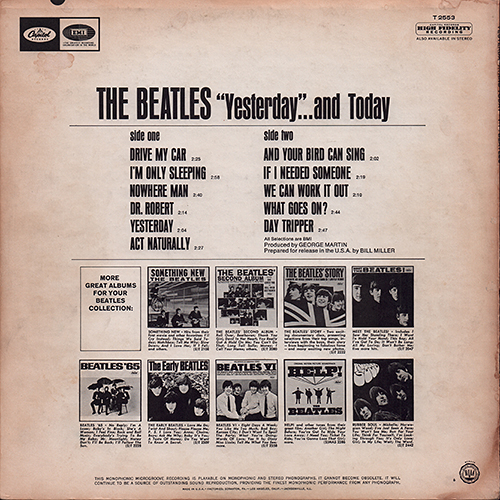 |
 |
 |
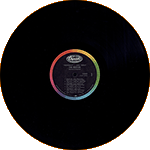 |
|||||||||||||||||||||||||
| INNER SLEEVE | FRONT COVER CLOSE UP | ||||||||||||||||||||||||||||
| FRONT --> Click |
BACK --> Click! |
||||||||||||||||||||||||||||
 |
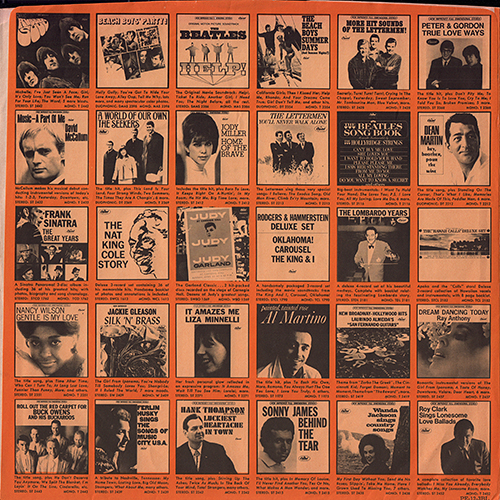 |
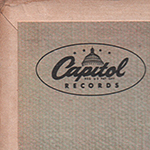 |
The Capitol
logo (without the phrase "HIGH FIDELITY") appear in black in
the upper left corner of the front sleeve. |
||||||||||||||||||||||||||
| FRONT COVER CLOSE UP | |||||||||||||||||||||||||||||
 |
The exposed portion of the back liner that wrapped around to the top of the jacket has the phrase "File Under: The Beatles" as well as a large black dot and the catalogue number. | ||||||||||||||||||||||||||||
| BACK COVER CLOSE UP | |||||||||||||||||||||||||||||
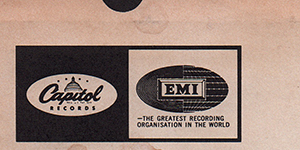  |
 |
||||||||||||||||||||||||||||
| The High Fidelity Recording logo and "Also
available in stereo" in uppercase letters in the upper right
corner. Capitol/EMI logo mark was printed at the upper left of the back cover. |
|||||||||||||||||||||||||||||
| BACK COVER CLOSE UP | |||||||||||||||||||||||||||||
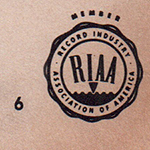 |
 |
||||||||||||||||||||||||||||
| The
lower portion of the back liner contains "MADE IN U.S.A. •
FACTORIES: SCRANTON, PA. - LOS ANGELES, CALIF. -
JACKSONVILL, ILL." and the RIAA (Record Industry Association
of America" logo. Most of the back liners have a small
numeral located near the lower right or left corner. These
numbers were used by Capitol to identify where the album
cover was manufactured. (6=L.A. factory) |
|||||||||||||||||||||||||||||
| LABEL CLOSE UP | |||||||||||||||||||||||||||||
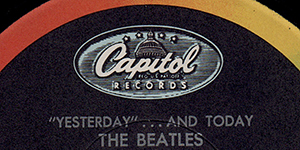 |
The original issue Capitol albums
were manufactured with black label backdrops with an outer
rim colorband. |
 |
|||||||||||||||||||||||||||
| Catalogue number
"T-2553" was printed at the right side of the center hole. "West Coast" Pressings have the master number aligned right. |
|||||||||||||||||||||||||||||
| LABEL CLOSE UP | |||||||||||||||||||||||||||||
| SIDE 1 --> Click! |
SIDE 2 --> Click! |
The First Pressings'
credits all songs on both sides as BMI. |
|||||||||||||||||||||||||||
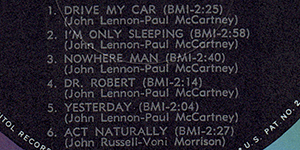 |
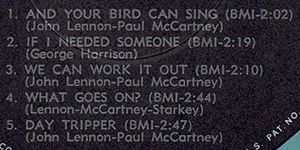 |
||||||||||||||||||||||||||||
| LABEL CLOSE UP | |||||||||||||||||||||||||||||
 |
The text of the perimeter print in blue on the original issue discs states "MFD. BY CAPITOL RECORDS. INC. U.S.A. T.M." to the left of a small Capitol logo, with "• MARCA REG. • U.S. PAT. NO. 2, 631,859" to the right. On some labels, the perimeter print is in white. | ||||||||||||||||||||||||||||
|
OTHER ITEM
|
|||||||||||||||||||||||||||||
| - | |||||||||||||||||||||||||||||
| LABEL | Capitol
Black
label with color band type-1 |
||||||||||||||||||||||||||||
| MIX | MONO |
||||||||||||||||||||||||||||
| VINYL COLOR | Black |
||||||||||||||||||||||||||||
| PRESS FACTORY |
SLEEVE | West
Coast: Bert-Co Enterprise of Los Angeles |
|||||||||||||||||||||||||||
| VINYL | Los
Angeles, California |
||||||||||||||||||||||||||||
| FACTORY CODE | 6 |
||||||||||||||||||||||||||||
| MATRIX No. | SIDE 1 |
T-1-2553-F-21'
(hand etched) 2 * (machine
stamped) |
|||||||||||||||||||||||||||
| SIDE 2 |
T-2-2553-F-17'
(hand
etched) 2 * (machine stamped) |
||||||||||||||||||||||||||||
| PUBLISHER'S NAME |
- |
||||||||||||||||||||||||||||
|
"SUBSIDIARY" PRINT
|
- |
||||||||||||||||||||||||||||
| COVER FORM |
Single
type.
Housed in a cardboard jacket. “Peeled” versions with the trunk cover removed |
||||||||||||||||||||||||||||
| INNER SLEEVE | Capitol
Company
Sleeve Type-6-2: Orange sleeve (Sound Great!) Tub cut top. |
||||||||||||||||||||||||||||
| COVER DESIGN/ PHOTO/ NOTES | Photo:
Robert
Whitaker (from an March, 1966 photo session) |
||||||||||||||||||||||||||||
| PRODUCER | Produced
by
Geore Martin |
||||||||||||||||||||||||||||
|
COMMENTS
|
"Yesterday and Today" is the
Beatles' tenth Capitol Records release in the United States.
The LP was released in both mono and stereo versions. The Yesterday and Today album, released in June 1966, was originally printed with a cover depicting the Beatles dressed in butcher smocks, surrounded by pieces of raw meat and plastic doll parts. Due to public outrage, the album was quickly withdrawn and the cover replaced by one with a more modest design. The value of the copies of Yesterday and Today with a Butcher cover lies with the cover itself; the records within them are relatively common. Capitol Records produced the better part of a million copies of that album in 1966. Many of those covers were either destroyed or altered, and the surviving examples can often sell for a breathtaking amount of money on the collector’s market. Yesterday and Today was an album planned by the American record company alone and was compiled with little, if any, input from the Beatles themselves. The tracks were taken from a variety of sources.The album was given the title “Yesterday and Today” to take advantage of the song “Yesterday”, which had reached #1 on the American charts in October, 1965. As Yesterday and Today was intended to be a North American-only release (it would also be released in Canada), Capitol had not received artwork from Parlophone, and requested that the band’s management provided them with suitable artwork for the album cover. The photos supplied came from a photo shoot that the band had done in March, 1966 with photographer Robert Whitaker, which were originally intended to be used for a piece of conceptual art called “A Somnambulant Adventure.” For these photos, the Beatles were dressed in butcher smocks and sat on or stood around a bench while surrounded with parts from plastic dolls and raw meat. Though these photos were not taken with the intention of using them for an album cover, the band’s management submitted them to Capitol, and one of the photos was chosen to be used for the cover of the Yesterday and Today album. Whitaker had no idea that he’d inadvertently created the Butcher cover. As Beatles albums had continued to sell well since their arrival in America in early 1964, Capitol had high hopes for sales of Yesterday and Today. In anticipation of this, the company printed some 750,000 covers at their three pressing plants 1) Los Angeles, California 2) Scranton, Pennsylvania 3) Jacksonville, Illinois. The front cover slicks for the cover were printed on a special paper with a slightly rough texture, and the photo used was given a slightly grainy appearance in order to make the finished cover look somewhat as though it had been painted on canvas. At the time of the release of Yesterday and Today, record companies in America were still pressing records in both stereo and mono, as stereo records were playable only on stereo equipment and most buyers only had mono record players. Because of this, approximately 80%-90% of the finished covers were in mono, with the remainder in stereo. Several hundred copies of the finished Yesterday and Today album were shipped to radio stations and reviewers in order to help the album receive press attention prior to release. Most of the remaining copies were shipped to distributors around the country. Due to the controversial image depicted on the cover, reaction to the album from the few people who received advance copies was predictably hostile, and distributors and retailers expressed concern about the cover art. As the album’s release date approached, Sir Joseph Lockwood, the chairman of EMI, the company that owned Capitol Records, made the decision to recall the album. Distributors and reviewers were asked to return all copies of the album to Capitol Records, as described in an article in a contemporaneous article in Billboard magazine about the struggles of distributors to return the albums with the Butcher cover to the record company. It’s worth noting that while the copies of the Butcher cover that were sent to reviewers ahead of the release date are valuable, so is the letter from Capitol requesting that the album be returned to them. Capitol quickly came up with a replacement cover design; this one was much more innocuous and depicted the band surrounding a steamer trunk. This image may have been considered for use as the original cover of the album, and several different prototype cover slicks exist with slight variations on this image. The decision then needed to be made as to what to do about the returned albums, that had the design that would soon be known as the “Butcher cover.” The decision regarding what to do about the covers may have been made at the corporate level or by individual plant managers. At the Jacksonville, Illinois, plant, all of the returned copies had the records removed and the covers were reportedly taken to a landfill, where they were dumped into a hole that was then filled with water. At the Los Angeles and Scranton plants, a different decision was reached – the cover slicks with the new artwork would be pasted over the existing “Butcher cover” slicks. This process proved to be less expensive than reprinting the covers completely, but was also more time consuming. Not only was the process of precisely aligning a new slick over the old one a difficult task, but the finished covers also had to be trimmed at the mouth (the right edge) to account for any misalignment at the opening of the cover. Once the covers were either reprinted (Jacksonville) or modified (Los Angeles and Scranton), the albums were again shipped to distributors for their June 20, 1966 release date. It’s worth noting that the Butcher cover was released in the United States only in the vinyl format. Reel to reel tape and 8 track tape versions of the album were not issued until about a month after the record. By this time, the decision to use the second cover had already been made. Cassette copies of Yesterday and Today were not released until two years later and all of them were issued with the later trunk cover photo. On the day of release, the album that most buyers saw in the stores was the second cover with the steamer trunk photo. Probably half of those actually had Butcher cover slicks underneath them. A small handful of original copies with the exposed Butcher cover slick were sold at retail, though it has been estimated that only a few hundred copies were sold this way. There have been a couple of copies offered for sale on the market over the years that still had both the original shrink wrap and price sticker intact, demonstrating that at least a few copies of the withdrawn original cover did reach store shelves. Within a few months, all of the “pasteover” copies of Yesterday and Today had been sold, and by the end of 1966, all of the copies seen in stores were copies that had been manufactured with the trunk cover only. By January, 1967, four distinctly different versions of Yesterday and Today were in existence. 1) 1st. State: the original issues with the “Butcher cover” photo 2) 2nd. State: the second version of the album, with the trunk cover slick pasted over the Butcher cover 3) 3rd. State: the buyer-created “peeled” versions with the trunk cover removed 4) Trunk Cover: the fourth version, which was manufactured with the trunk cover slick. (from: RareRecord.net "The Butcher Cover - The Beatles' Best Known Album") The back liner contains "MADE IN U.S.A. • FACTORIES: SCRANTON, PA. - LOS ANGELES, CALIF. - JACKSONVILL, ILL."" and the RIAA (Record Industry Association of America" logo. Most of the back liners have a small numeral located near the lower right or left corner. These numbers were used by Capitol to identify where the album cover was manufactured. Capitol did not fabricate its own album covers. Capitol required the cover manufacturer to place a factory identification number on the back liners. The fabricators added a small number, usually in the lower right corner. The following factories used the following identification numbers in the mid-60s:
The original issue Capitol albums were manufactured with black label backdrops with an outer rim colorband. Label copy information specific to each album appears in silver print. The labels for records manufactured on: 1) The East Coast were printed by Keystone Printed Specialties, Inc. in Scranton, Pensylvania. 2) The West Coast were printed by Bert-Co Enterprises in Los Angeles, California. The East Coast and West Coast mono label variations: 1) First pressings of the East Coast label has master number centered. 2) First "West Coast" Pressings have master number aligned right. 3) Jacksonville pressings of the album have West Coast labels prepared by Bert-Co. From the not-yet-released Revolver, the tracks "I'm Only Sleeping", "Dr. Robert" and "And Your Bird Can Sing". The mono mixes were different from those used for the August 1966 release of Revolver, while the stereo version of Yesterday and Today initially contained duophonic ("fake stereo") mixes of the three songs. Subsequent issues of Capitol's album used the true stereo mixes. |
||||||||||||||||||||||||||||
